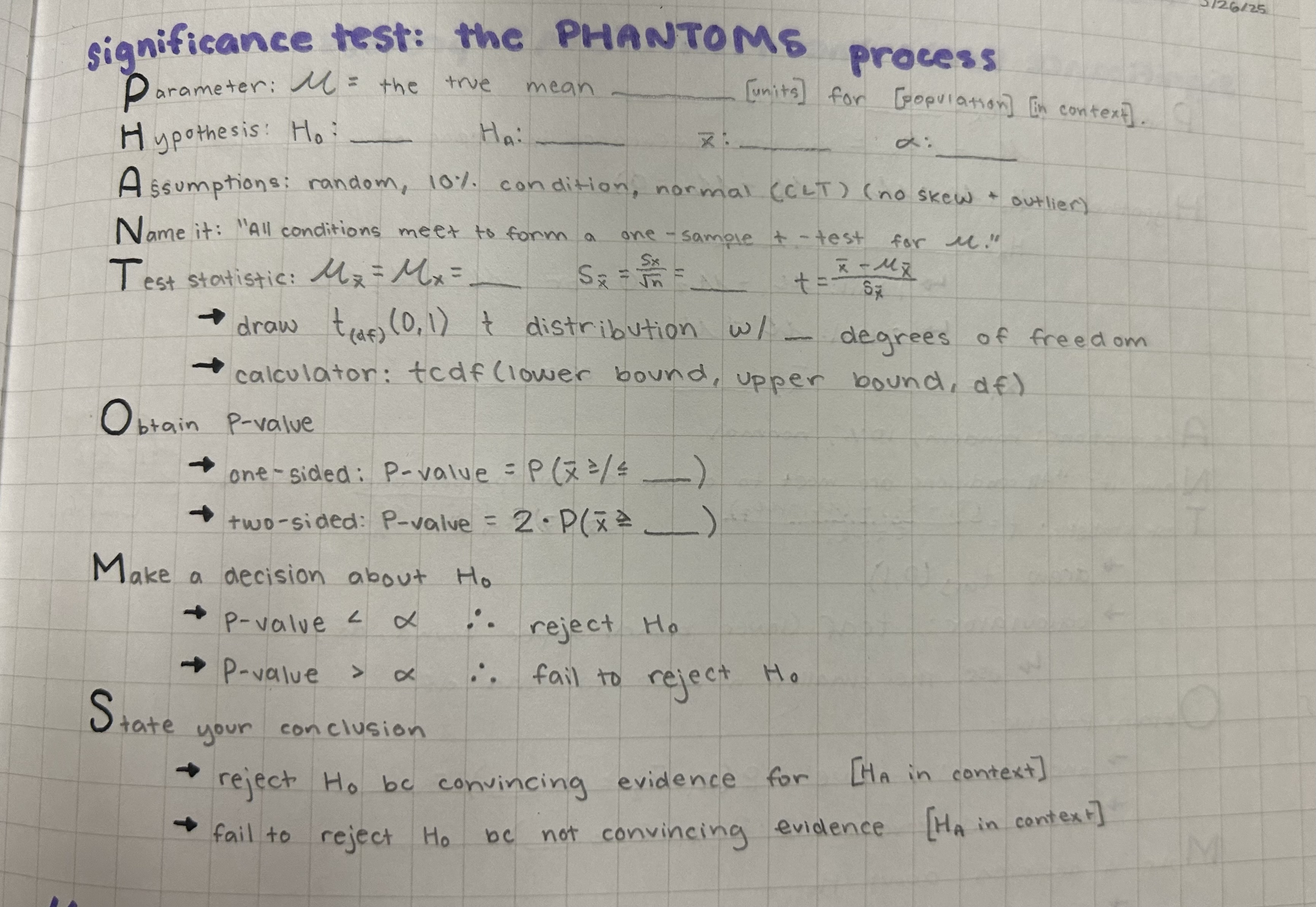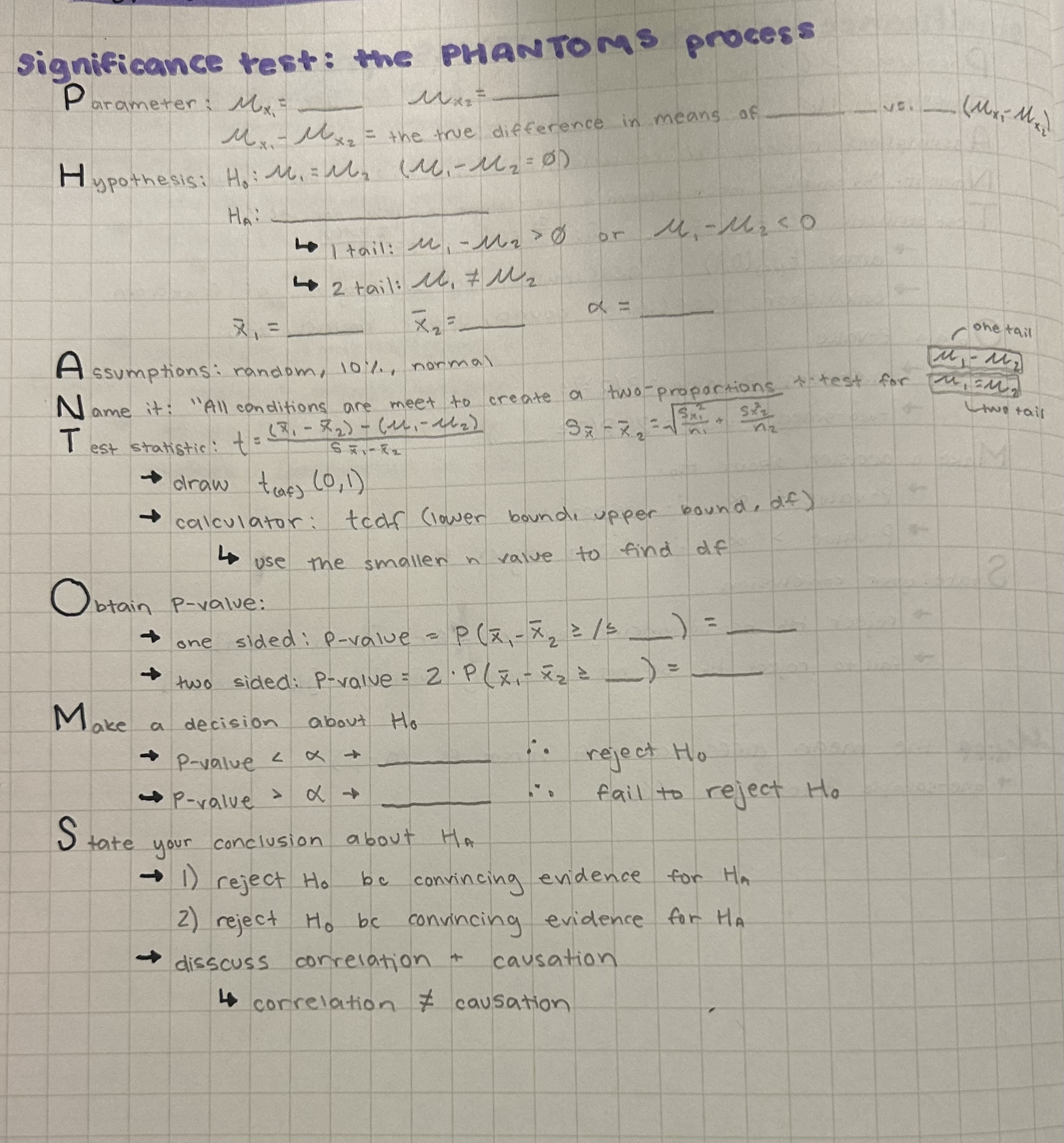AP Stats Ch 9 & 11
1/15
There's no tags or description
Looks like no tags are added yet.
Name | Mastery | Learn | Test | Matching | Spaced |
|---|
No study sessions yet.
16 Terms
null hypothesis (H⌄0)
a claim that we weigh evidence against in a significance test
alternative hypothesis (H⌄a)
a claim that we are trying to find evidence for
one-sided alternative hypothesis
states that a parameter is either greater than or less than the null
two-sided alternative hypothesis
states that the parameter is different from the null value (greater than and less than)
P-value of a test
the probability of getting a p̂ or more extreme purely by chance
significance level (𝛼)
the value that we use as a boundary for deciding whether an observed result is unlikely to happen by chance alone when the null hypothesis is true
𝛼 usually is 0.05 or less - statistically significant
𝛼 should be stated before the data is produced
standardized test statistic (z score)
measures how far a sample statistic is from what we would expect if the null hypothesis were true (in standard deviation units)
standardized test statistic = (statistic - parameter) / standard deviation of statistic
significance test: the PHANTOMS process
Parameter: P = _______
Hypothesis: H⌄0: ____, H⌄a: ____, p̂ = ____, & 𝛼 = ____
Assumptions: random, 10% condition, large counts condition
Name: “All conditions are met to create a one-sample (proportion) Z test for P.”
Test statistic: z = ____
draw N(0, 1) normal distribution for z
Obtain P-value: (& interpret)
one-sided: P-value = P(z ≥/≤ ___)
two-sided: P-value = 2P(z ≥ ___)
state: “Assuming H⌄0 is true (P = ___), there is a <p-value> probability of getting a sample proportion of <p̂> or <more extreme / greater than / less than> purely by chance.”
Make a decision about H⌄0:
P-value < 𝛼 → reject H⌄0
P-value > 𝛼 → fail to reject H⌄0
no naked numbers
State your conclusion about H⌄a:
reject H⌄0 bc convincing evidence for <H⌄a in context>
fail to reject H⌄0 bc, not convincing evidence for <H⌄a in context>
type I error
occurs if we reject H⌄0 when H⌄0 is true (false positive)
P(type I error) = 𝛼
“We found convincing evidence for <H⌄a> when in reality <H⌄0> is true.”
power of a test
the probability that the test will find convincing evidence for H⌄a when H⌄a is true
the power of a significance test will become larger when…
the sample size (n) is larger
decreases variability
the significance level (𝛼) is larger
the null and alternative parameter values are farther apart
difference in proportions significance test: the PHANTOMS process
Parameter:
P⌄1 = _______
P⌄2 = _______
P⌄1 - P⌄2 = the true difference in proportions of _______________ _______ vs. _______ (<P1> - <P2>)
Hypothesis:
H⌄0: P⌄1 - P⌄2 = 0
H⌄a: ____
P⌄1 - P⌄2 > 0 (1 tail)
P⌄1 > P⌄2
P⌄1 - P⌄2 < 0 (1 tail)
P⌄1 < P⌄2
P⌄1 - P⌄2 ≠ 0 (2 tail)
p̂⌄c = (x1 + x2) / (n1 + n2) = ____
𝛼 = ____
Assumptions:
Is the sample random?
Do the samples meet the 10% condition?
Do the samples meet the large counts condition?
n1(p̂⌄c) ≥ 10 & n1(1 - p̂⌄c) ≥ 10
n2(p̂⌄c) ≥ 10 & n2(1 - p̂⌄c) ≥ 10
Name:
“All conditions are met to create a two-proportion Z test for P⌄1 - P⌄2.”
Test statistic:
z = [(p̂⌄1 - p̂⌄2) - (P⌄1 - P⌄2)] / S⌄p̂⌄1 - p̂⌄2
S⌄p̂⌄1 - p̂⌄2 = √[p̂C(1 - p̂C)/n1 + p̂C(1 - p̂C)/n2]
draw N(0, 1) normal distribution for z
Obtain P-value:
one-sided: P-value = P(z ≥/≤ ___) = ____
two-sided: P-value = 2P(z ≥ ___) = ____
Make a decision about H⌄0:
P-value < 𝛼 → ________ ∴ reject H⌄0
P-value > 𝛼 → ________ ∴ fail to reject H⌄0
State your conclusion about H⌄a:
reject H⌄0 bc convincing evidence for (H⌄a in context)
fail to reject H⌄0 bc there is not convincing evidence for (H⌄a in context)
significance test for a population mean

μdiff
the mean difference in A versus B (A-B) (one-sample t test for μdiff)
significance test for a difference in means
